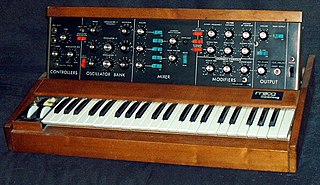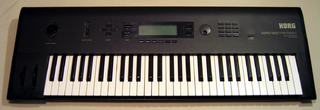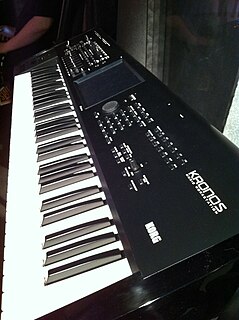Bowen, John Scott | |
|---|---|
| Nationality | American |
| Occupation | Sound designer |
John Scott Bowen is an American sound designer known for his early work with synthesizers. [1]
Bowen, John Scott | |
|---|---|
| Nationality | American |
| Occupation | Sound designer |
John Scott Bowen is an American sound designer known for his early work with synthesizers. [1]
Bowen started out as the first official Moog clinician in 1973, demonstrating and contributing to designs for Moog Music. In 1976 he started working with Dave Smith to promote his Model 800 sequencer, and then helped specify the Model 700 Programmer. This association led to the development of the Prophet 5, and then on to the entire line of Sequential Circuits products. Bowen was responsible for the original 40 factory programs of the Prophet 5, and as Sequential's Product Specialist created 99% of all of the factory sounds and sequences (as well as the original Prophet VS waveshapes), also contributing to the User Interface (UI) design for the following Sequential products: Prophet 5, Prophet 10, Prophet 600, Prophet T-8, Prophet VS, Drumtraks, 6-Trak, MultiTrak, Tom, Max, Studio 440, and the Prophet 2000 and 3000 libraries.
Also during this time, Bowen was bassist and synthesist for the Nielsen Pearson band (1974–1980), performing on 3 albums with them. He also assisted Billy Cobham in setting up his Moog Modular 55 for various recording sessions (one being Stanley Clarke's 'School Days'), as well as appearing on several other projects, most notably with Herbie Hancock for the Eddie Henderson release, Mahal (Capitol, 1978).
At the end of 1987, Sequential was bought by Yamaha. After a brief stint there, the Sequential design team moved over to Korg, where John was product manager for the Wavestation series (keyboard, AD, and SR racks, 1989–1992). In 1993 he became part of the original Korg OASYS project team, culminating with the first public presentations of the OASYS keyboard at NAMM and Musik Messe in early '96. After the cancellation of the project in September, 1996, John took part in the Korg Z1 voicing. A year later, with the go-ahead from Korg Japan to resurrect the OASYS technology, he found himself back doing UI design for OASYS PCI synths and effects.
In August 1998 Bowen joined Creamware to develop the Modular system used in Pulsar/SCOPE, as well as assisting in some of their other synth design projects. Now working as an independent, he was involved in doing some of the OASYS PCI factory voicing, as well as consulted for Native Instruments in their emulation of a Prophet 5 (called the Pro-52), a VST Virtual Instrument. Later, he helped complete representations of the Pro One and Prophet 5 for the Creamware series of audio cards.
Bowen departed Creamware and, after a short consulting assignment with Native Instruments, announced his own software synth company, Zarg Music, in November 1999. He developed and released a bundle of four software synthesizers for the SCOPE platform by June of the following year. These software synthesizers were the beginnings of what would become a new Bowen hardware synthesizer design. [2]
At the 2007 Musikmesse show, Bowen showed a prototype of a new original Bowen-designed keyboard synthesizer named Solaris, to be manufactured in cooperation with Sonic Core and released under the John Bowen Synth Design brand, [3] and eventually Solaris was released. [4] [5]

An analogsynthesizer is a synthesizer that uses analog circuits and analog signals to generate sound electronically.
A software synthesizer or softsynth is a computer program that generates digital audio, usually for music. Computer software that can create sounds or music is not new, but advances in processing speed now allow softsynths to accomplish the same tasks that previously required the dedicated hardware of a conventional synthesizer. Softsynths may be readily interfaced with other music software such as music sequencers typically in the context of a digital audio workstation. Softsynths are usually less expensive and can be more portable than dedicated hardware.
A music workstation is an electronic musical instrument providing the facilities of:

The Yamaha CS-80 is an analog synthesizer released in 1977. It supports true 8-voice polyphony, with two independent synthesizer layers per voice each with its own set of front panel controls, in addition to a number of hardwired preset voice settings and four parameter settings stores based on banks of subminiature potentiometers.
Sequential is an American synthesizer company founded in 1974 as Sequential Circuits by Dave Smith. In 1978, Sequential released the Prophet-5, the first programmable polyphonic synthesizer; it became a market leader and industry standard, used by artists including Michael Jackson, Madonna, and John Carpenter. In the 1980s, Sequential was pivotal in the development of MIDI, a technical standard for synchronizing electronic instruments.

The Korg OASYS is a workstation synthesizer released in early 2005, 1 year after the successful Korg Triton Extreme. Unlike the Triton series, the OASYS uses a custom Linux operating system that was designed to be arbitrarily expandable via software updates, with its functionality limited only by the PC-like hardware.

David Joseph Smith was an American engineer and founder of the synthesizer company Sequential. Smith created the first polyphonic synthesizer with fully programmable memory, the Prophet-5, which had a major impact on the music industry. He also led the development of MIDI, a standard interface protocol for synchronizing electronic instruments and audio equipment.
Arturia is a French electronics company founded in 1999 and based in Grenoble, France. The company designs and manufactures audio interfaces and electronic musical instruments, including software synthesizers, drum machines, analog synthesizers, digital synthesizers, MIDI controllers, sequencers, and mobile apps.

The Prophet-5 is an analog synthesizer manufactured by the American company Sequential. It was designed by Dave Smith and John Bowen in 1977, who used microprocessors, then a new technology, to create the first polyphonic synthesizer with fully programmable memory. This allowed users to store sounds and recall them instantly rather than having to reprogram them manually; whereas synthesizers had once created unpredictable sounds, the Prophet-5 moved synthesizers to producing "a standard package of familiar sounds".
Polyphony is a property of musical instruments that means that they can play multiple independent melody lines simultaneously. Instruments featuring polyphony are said to be polyphonic. Instruments that are not capable of polyphony are monophonic or paraphonic.

The Korg Polysix(PS-6) is a six-voice programmable polyphonic analog synthesizer released by Korg in 1981.

The Korg Wavestation is a vector synthesis synthesizer first produced in the early 1990s and later re-released as a software synthesizer in 2004. Its primary innovation was Wave Sequencing, a method of multi-timbral sound generation in which different PCM waveform data are played successively, resulting in continuously evolving sounds. The Wavestation's "Advanced Vector Synthesis" sound architecture resembled early vector synths such as the Sequential Circuits Prophet VS.

A synthesizer is an electronic musical instrument that generates audio signals. Synthesizers typically create sounds by generating waveforms through methods including subtractive synthesis, additive synthesis and frequency modulation synthesis. These sounds may be altered by components such as filters, which cut or boost frequencies; envelopes, which control articulation, or how notes begin and end; and low-frequency oscillators, which modulate parameters such as pitch, volume, or filter characteristics affecting timbre. Synthesizers are typically played with keyboards or controlled by sequencers, software or other instruments, and may be synchronized to other equipment via MIDI.

Korg M3 is a music workstation synthesizer manufactured by Korg Corporation and introduced at the Winter NAMM show during January, 2007, being released four months later. The M3 is the successor of the famous Triton series. The name is based on the former M1, which was considered a revolutionary synth at the time.

Sonic Core is a German developer of digital audio systems, that in 2007 took over some of the assets of Creamware, and continues to support, manufacture and develop the Scope DSP hardware platform and associated software that was originally developed by that company.

The Kronos is a music workstation manufactured by Korg that combines nine different synthesizer sound engines with a sequencer, digital recorder, effects, a color touchscreen display and a keyboard. Korg's latest flagship synthesizer series at the time of its announcement, the Kronos series was announced at the winter NAMM Show in Anaheim, California in January 2011.

The Korg OASYS PCI is a DSP-based PCI-card for PC and Mac released in 1999. It offers many synthesizer engines from sampling and substractive to FM and physical modelling. Because of its high market price and low polyphony, production was stopped in 2001. About 2000 cards were produced.

The Arturia MiniBrute is a synthesizer manufactured by Arturia. Although the MiniBrute was the first piece of hardware created by Arturia—which had previously exclusively marketed software synthesizers—it generated strong sales.
The history of home keyboards lies in mechanical musical instrument keyboards, electrified keyboards and 1960s and 1970s synthesizer technologies.